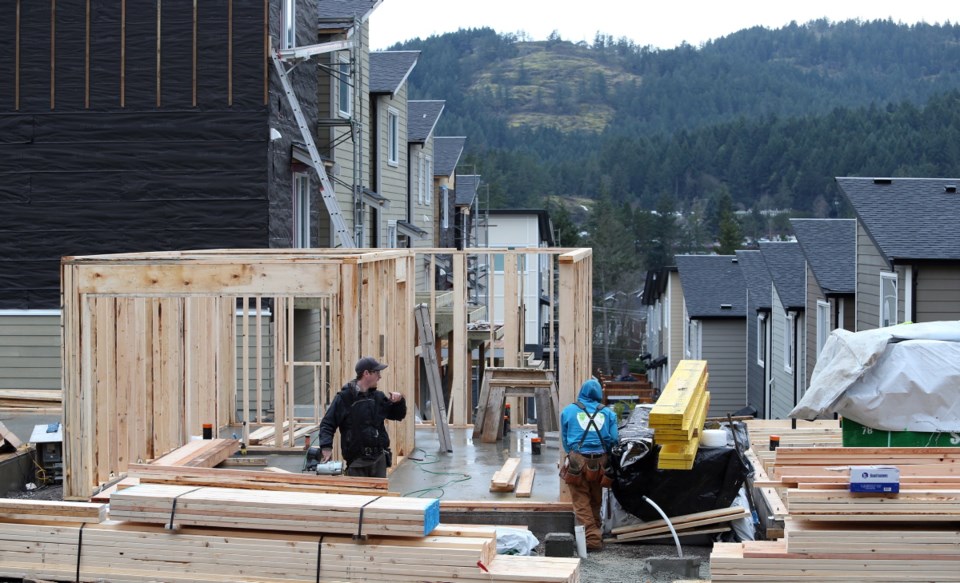Capital region construction watchers are bullish about the coming year, saying they expect strong demand for new housing to continue.
Last year saw 2,008 housing starts in Greater Victoria, marking the first time since 2010 that the number of new single-family homes, condominiums, townhouses and apartments topped 2,000.
Residential construction rebounded last year from 1,315 starts in 2014.
“We want to see that 2,000 mark, because 2,000 really represents a healthy home-building economy,” Casey Edge, executive director of the Victoria Residential Building Association, said Monday.
Edge expects continued low interest rates and good employment numbers to bolster housing.
The National Association for Home Builders said in an April report that building 100 rental apartments typically creates a one-year impact of 161 jobs, $11.7 million in income and $2.2 million in taxes and revenue for local governments. The report said that construction of 100 single-family homes creates 394 jobs, $28.7 million in income and $3.6 million in local government revenue.
Housing starts in the capital region were fuelled by increased demand as real estate sales grew by 24 per cent from 2014.
Multi-family unit starts (usually condominiums) jumped to 1,321 in 2015, up 73 per cent from 764 the previous year, said Canada Mortgage and Housing Corp. in a report on Monday. Victoria was a condo hot-spot, with 643 units starting last year. Langford was in second place with 243 units. Single-family house starts climbed to 687, up 25 per cent, from 551 in 2014.
More single-family starts indicate that millennials (born starting in the early 1980s) are buying their first houses and starting to “get traction in our economy,” Edge said.
Langford had the highest number of single-family housing starts, at 284, followed by Saanich, which had 80.
Guy Crozier of the ReMax Preferred Homes Team said the West Shore has land available for housing.
Crozier represents the Limona Group, developing Summerstone in Langford. The project has 69 single-family strata homes, priced between $324,000 and $354,000. Features include gas heat without ducts resulting in lower heating costs, high ceilings, open plans and strata fees of $20 per month.
Nearly half the properties are sold, Crozier said. Limona focuses on building affordable housing. It buys and rezones land and develops it.
Although there is a feeling of optimism about the local construction picture, the picture is not as upbeat nationally. A new Bank of Canada business outlook survey said that investment and hiring plans are down to 2009 levels.
Even so, Cameron Muir, chief economist of the B.C. Real Estate Association, said this province’s economy will be among the top performers this year, as it was in 2015. He said it is especially evident on the south coast, which has been largely unscathed by the oil and gas downturn.
“Because our economy is performing relatively well and we are starting to see some pretty solid job growth, consumers are quite confident, so we’ve seen retail sales grow quite dramatically,” said Muir.
Muir predicts the capital region’s housing market will see continued momentum in the first half of this year, pulling back somewhat after that. That will be because pent-up demand is being met and interest rates may increase later this year.
Greg Baynton, CEO of the Vancouver Island Construction Association, predicts B.C. will continue to see increases in residential and non-residential construction. The expectation is that total 2015 building permit values on Vancouver Island — and the capital region in particular — will increase by 15 to 20 per cent over the previous year.
At the end of the third quarter of last year, close to 34,000 people were employed in construction on Vancouver Island, with about 15,000 in Greater Victoria, Baynton said.
The most recent capital region building permits from Statistics Canada came in at $60.6 million for November, up by five per cent year-over-year. Along with residential building, Baynton points to other construction such as the Capital Park mixed use development near the legislature by Concert Properties and Jawl Properties, as well as the Jawl’s 1515 Douglas St. office and commercial development, and various Department of National Defence improvements.



